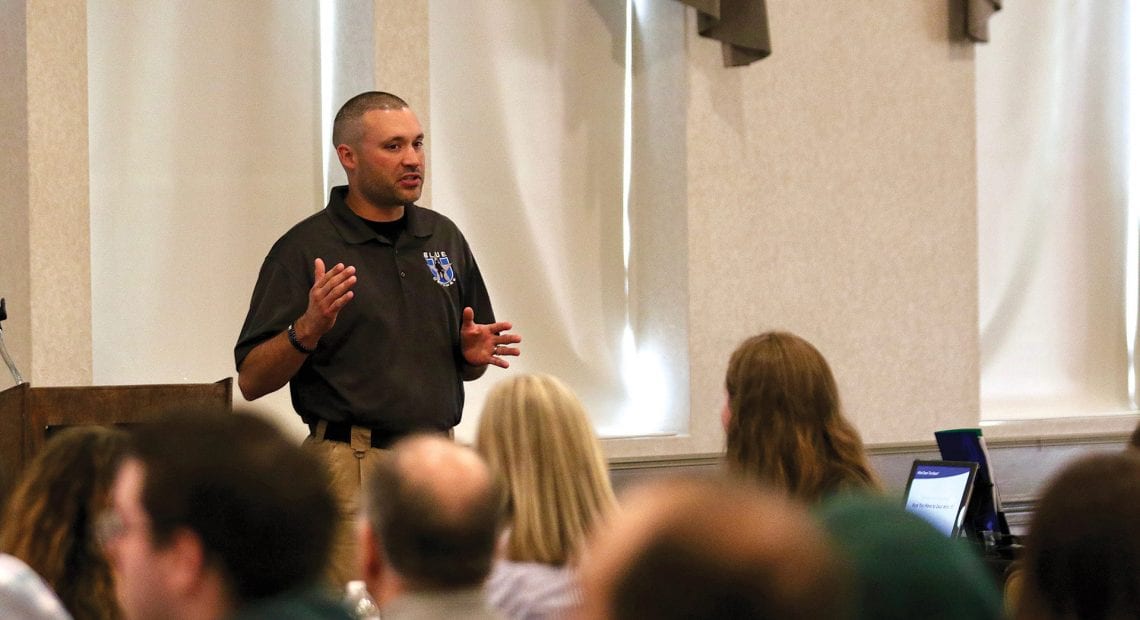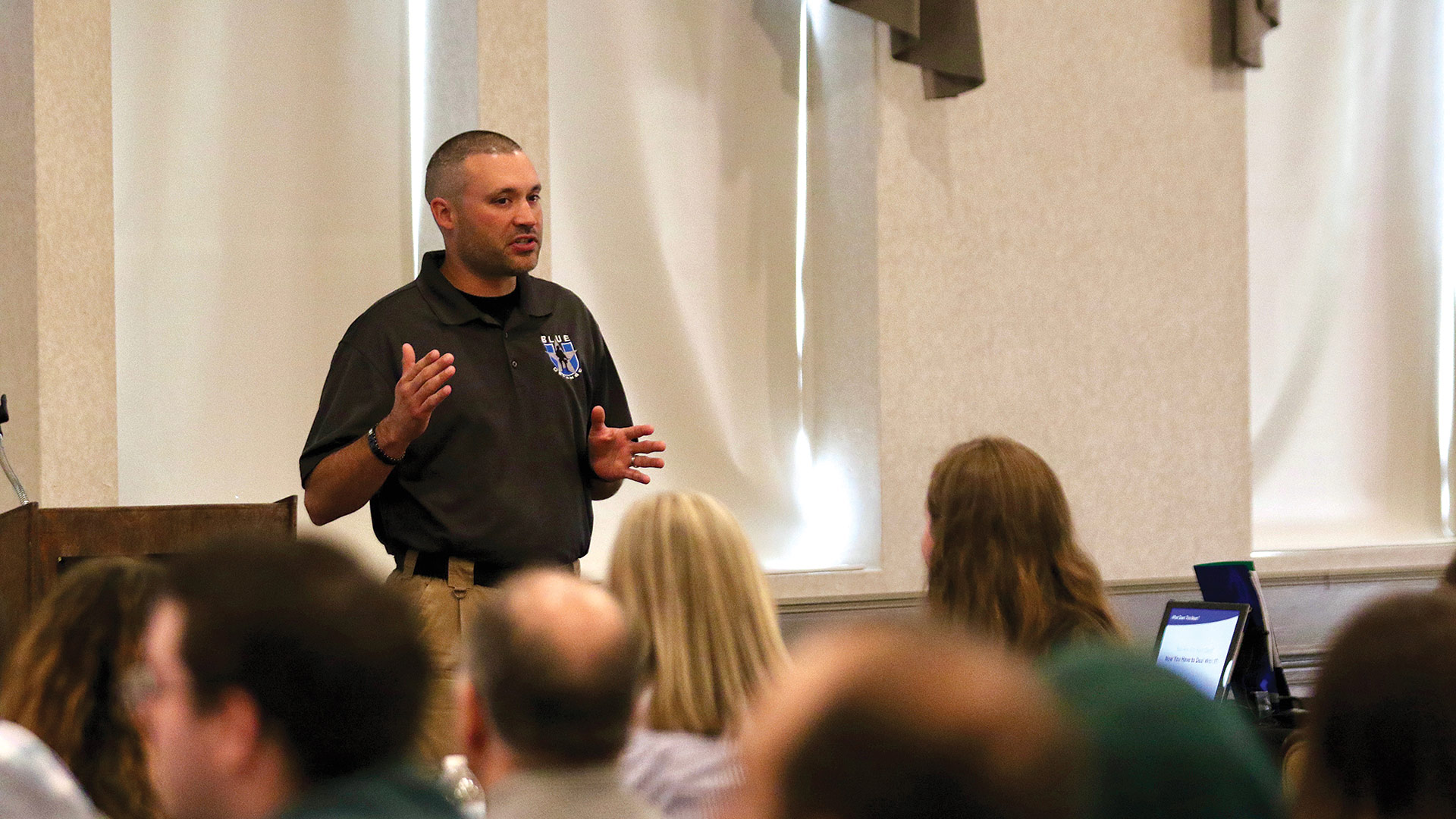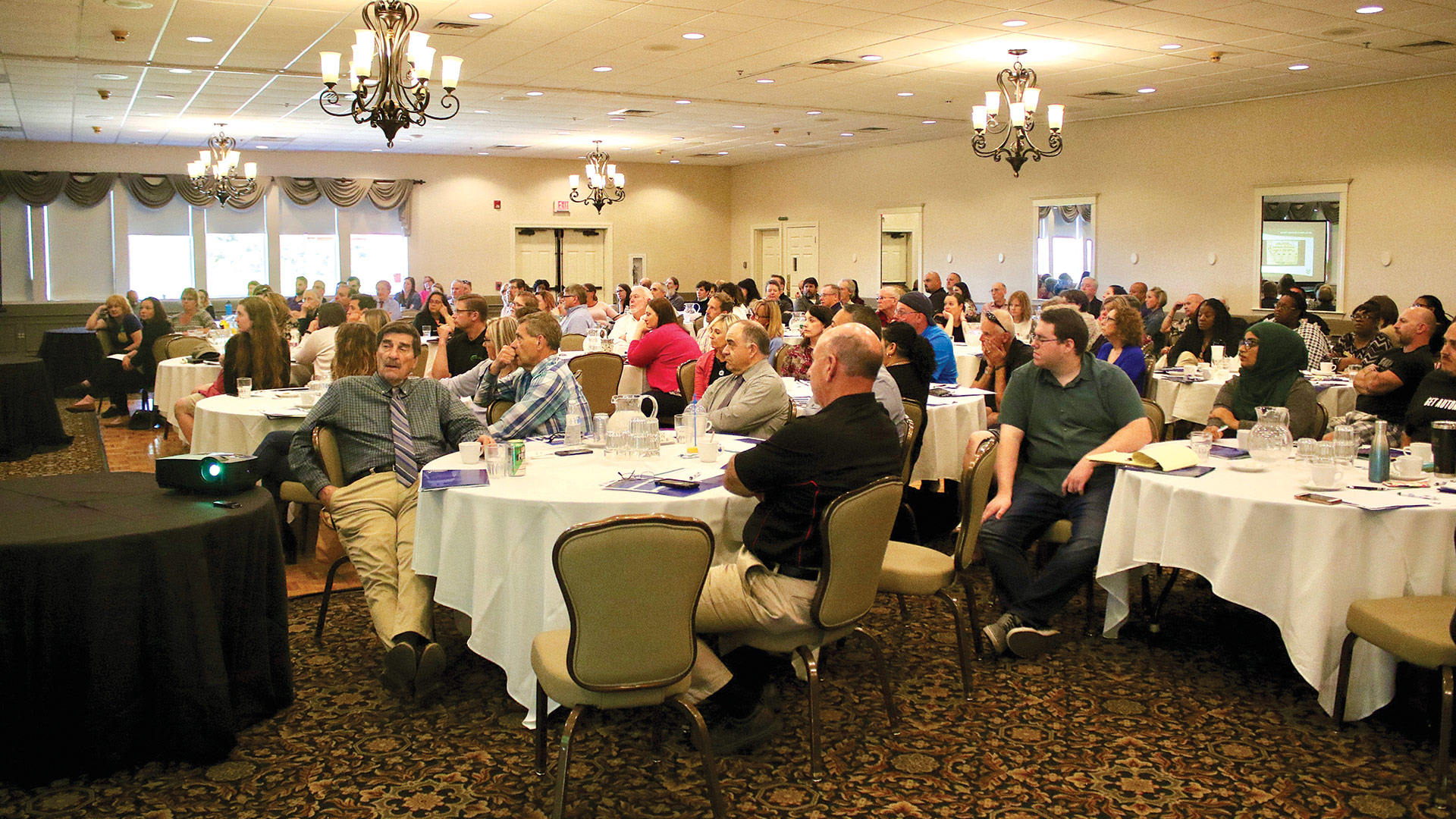
Seminar on Workplace Violence Emphasizes People, Not Technology
Rethinking Safety

Joe Hileman of Blue-U Defense addresses the audience gathered at the recent seminar on workplace violence.
Sarah Corrigan thought the new security systems being implemented at OMG Inc.’s several locations would be sufficient to keep employers safe from any sort of outside danger.
But a recent workplace-violence training session convinced her that keeping an office or building safe at a time when active-shooter incidents occur almost weekly in the U.S. is far more about educating and training people than it is about technology — although technology is certainly important.
Corrigan, vice president of Human Resources and Environmental Health and Safety for Agawam-based OMG, said she went into the session, hosted by the Employers Assoc. of the NorthEast (EANE) and presented by Blue-U Defense, expecting to receive some type of plan for how to deal with these types of tragic incidents.
Instead, she came out knowing it was up to her to talk with her employees about how they can each help themselves survive such a situation.
“I expected them to give us a process where there would be something set that we follow, so that was different to me, but it made a lot of sense,” she said, adding that she was surprised to hear the instructors actually warn against making a detailed plan.
Blue-U President and CEO Terry Choate Jr. told his audience of 150 business owners, managers, and rank-and-file employees that active-shooter training can oftentimes be too descriptive, putting the lives of those in the path of danger at even higher risk.
“As alarming as some of those videos are to watch, it is truly a reality. We’re really at a point where we need to take matters into our own hands; we have to be proactive at this point. It’s almost like, if we don’t do anything, we can’t expect any change.”
“Most of the active-shooter training across the country is ‘run, hide, and fight’ based. The problem with run, hide, fight is we already know that,” Choate said. “In the end, it means nothing. The key becomes how, when, and where do we run? How, when, and where do we hide? How, when, and where do we fight?”
This was the key takeaway from the three-hour session, hosted by EANE twice earlier this month — on June 12 at the Log Cabin in Springfield and on June 13 at at the Mandell Jewish Community Center in West Hartford.
The sessions were prompted by recent events — all too many of them, including the May 30 mass shooting at a municipal building in Virginia Beach, Va. — and alarming statistics. Indeed, according to the Gun Violence Archive, there were 340 mass shootings in 2018, compared to 269 in 2014. Meanwhile, during the presentation, Choate said the number-one cause of death for women in the workplace is workplace violence.
Those numbers help explain why the MassHire Springfield Career Center office, located in the Springfield Technology Park across from Springfield Technical Community College, was uninhabited on the afternoon of June 12, with all 28 employees attending the session at the Log Cabin.
Executive Director Kevin Lynn said his staff had been asking to do a training like the one put on by EANE, and he jumped at the opportunity.
“I think the issue really is that, every time we turn on the news and hear about one of these shootings, you think, ‘do you know what to do? What’s the right thing to do?’ he told BusinessWest. “You’re always sort of guessing.”
And guessing isn’t what he wants to be doing, or wants anyone else on his staff doing, he said, adding that this was a big motivator for sending his team to the training.
The audience at the Log Cabin was attentive and responsive as Choate and his colleague, Joe Hileman, went through their presentation, and the crowd fell silent when listening to the disturbing audio of the Columbine High School shooting in 1999.
Using that tape and videos of other mass shootings, the two explained that, although it may be a difficult thing to think and talk about such incidents and the steps needed to prevent one, such discussions are necessary in this day and age.
Pam Thornton, director of Strategic HR services at EANE, agreed, and said part of the agency’s role as an employer partner has become keeping the employees it serves safe, prompting such programs as the recent training sessions.
“As alarming as some of those videos are to watch, it is truly a reality,” she said. “We’re really at a point where we need to take matters into our own hands; we have to be proactive at this point. It’s almost like, if we don’t do anything, we can’t expect any change.”
Lynn added that the training session forced him to think about things differently, noting that being a company that regularly interacts with the public, serving 12,000 people annually, heightens the need for security.
“There’s really not a lot of room to operate; a building from the 1800s is not really built for this kind of reality,” he said, referring to the Tech Park, part of the Springfield Armory complex and later home to Digital Equipment Corp.
Like OMG, Lynn said he is looking into renovations that could potentially make the building safer, but for now, he said his employees were thankful for the training.
Whether working with organizations as large as OMG or nonprofits as small as MassHire, Blue-U focuses on giving people the tools to mentally deal with a life-threatening situation.
Choate told the audience at the Log Cabin that one of the biggest problems with active-shooter training in these times is that the mental aspect of the problem is not dealt with. Another huge problem comes with overpreparing for a workplace-violence situation.
“We cannot assume what a bad guy or threat is going to do when they come into the building,” he said.
OMG Inc. is in the process of upgrading its security systems, including the installation of cameras and using badges for all 300-plus employees in its Agawam facility, but the company’s leaders now know that a conversation needs to be started with its workers as well.
“There are a lot of doors, a lot of ways to get in,” said Corrigan. “You can’t protect all of those means of access, so you have to teach employees to think for themselves so that they have a plan.”
Kristen Pospolita, HR manager at OMG, said the training session aligned with what the company is currently focusing on.
“I thought that it goes in line with what we are trying to do at OMG, which is to empower our employees to take accountability and responsibility for their own safety in every aspect of the job,” she said, adding that being careful while operating machines and picking up spills on the floor are other ways to be self-aware. “This is just one more step in keeping us all safe. ‘See something, say something’ can be very helpful in lots of different types of situations.”
While a mass shooting or violent crime in the workplace is still not exactly a common occurrence, Choate said such matters are, unfortunately, something people are forced to think about in today’s world. Taking the necessary precautions and thinking about how one would respond in an active-shooter situation can be the difference between living and dying.
“No matter what we do, we will never be able to stop acts of mass violence entirely; it will not happen,” said Choate. “That doesn’t mean we can’t try.”
Kayla Ebner can be reached at [email protected]






